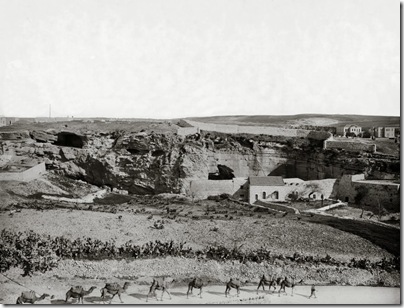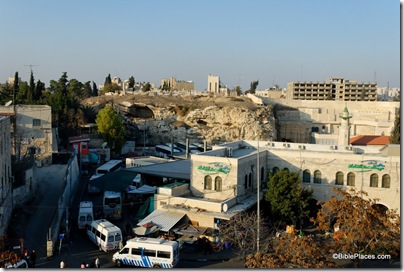General Charles Gordon was a well-known British leader when he came to live near Jerusalem in 1882, often visiting the home of Horatio and Anna Spafford, founders of the American Colony. From their quarters atop the northern wall of the Old City, Gordon had a view of a rocky escarpment in which he identified the features of a skull. He identified this location as the “Place of the Skull” (Aramaic: Golgotha; Latin: Calvary). Around the corner was an ancient tomb which he believed was the empty tomb of Christ. A decade later, the property was purchased by a concerned group of Christians in England and the Garden Tomb Association was formed.
In this photo, taken between 1898 and 1914, the view is similar to the one that Gordon had from the American Colony home. The caves that form the eye sockets of the skull are visible just left of center. The tomb is out of view behind the wall on the left side. On the top of the hill some tombs of the Muslim cemetery can be seen. The camels are walking east along what is today a busy four-lane street.
The photo below was taken in 2006 and the most prominent feature is the bus station. The two “eye sockets” are visible, but most of the rest of the landscape is covered. If you believe that Jesus was crucified in this area, you’ll do better using the black and white photo to visualize the event.
Concerning the tomb’s authenticity, Robert Alexander Stewart Macalister wrote in 1907:
It is a pity that so much is claimed for [this tomb]; the prejudice raised thereby is apt to blind one to the fact that it is a remarkably interesting sepulchre. . . . In conversation with tourists at the hotel in Jerusalem I constantly hear such a remark as this: ‘I came to Jerusalem fully convinced that the Church of the Holy Sepulchre was the true site; but I went to the Church and saw all the “mummery” that goes on there, and I saw the Muhammadan soldiers guarding the place to prevent the Christians fighting. Then I went to that peaceful garden: and then I knew that the church was wrong, and that Gordon had found the real site.’ This is the most convincing argument that can be advanced in favor of the tomb, and it is obviously quite unanswerable (Palestine Exploration Quarterly, 1907, p. 232).
The top photo is one 15 photographs in a presentation of the Garden Tomb in the newly released Jerusalem CD, volume 2 of The American Colony and Eric Matson Collection. The presentation includes a carefully researched history of the area. Photo: Library of Congress, LC-matpc-06666.

